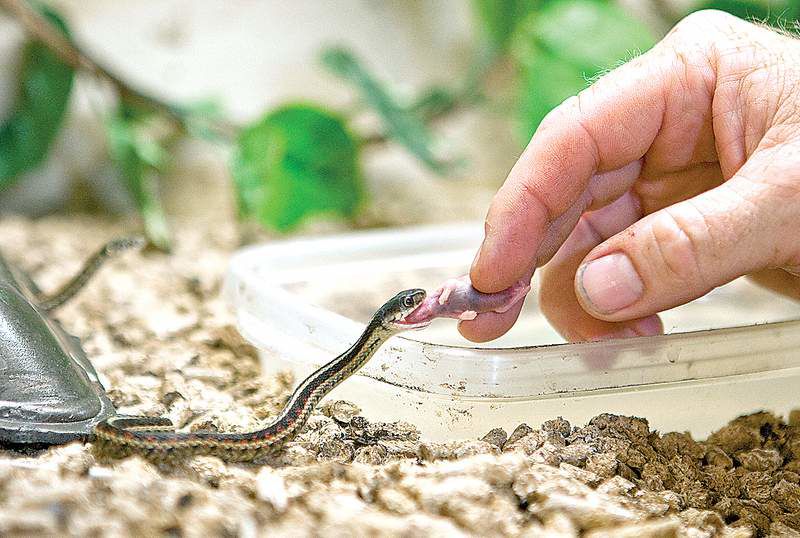The latest giant recall: millions of frozen rodents
Published 5:00 am Friday, July 30, 2010

- Steve Gilfillan feeds a frozen mouse to his snakes in Council Bluffs, Iowa, on Thursday. MiceDirect, a small Georgia company, will start irradiating future shipments of frozen mice sold over the Internet after its products were linked to a salmonella outbreak.
Take mice from freezer. Thaw (but not in the microwave, please). Feed to pet snakes. And do not forget to wash your hands.
That is the message from public health officials in the wake of salmonella outbreaks that have sickened more than 400 people, many of them snake owners or their children, in the United States and Great Britain. The illnesses have been traced to frozen mice sold over the Internet as food for exotic pets by a Georgia company called MiceDirect.
The company announced this week that it was recalling millions of frozen mice and that it would begin irradiating future shipments to kill infectious bacteria. MiceDirect also recalled frozen rats and baby chickens used as pet food by reptile fanciers, although those products had not been linked to the salmonella outbreaks.
The recall drew back the curtain on a world of exotic pet enthusiasts for whom there is nothing unusual about keeping a dozen snakes in the living room and a few zippered bags of mice in the freezer.
“It’s so much more convenient for the reptile keeper to have a bag of rodents in their freezer,” said Justin Kobylka, who raises and sells pythons in Toccoa, Ga., not far from the breeding operation of MiceDirect in Cleveland, Ga.
Buying frozen rodents saves repeated trips to the local pet shop to buy live mice, he said, and it spares squeamish owners from having to watch pets kill their prey.
“Some people aren’t ready to make that leap,” Kobylka said.
Health officials said that owners of reptiles should be mindful that such pets, including snakes and turtles, often carry salmonella and have been the cause of outbreaks in the past. Rodents carry similar risks, whether kept as pets or used as food for other animals. In humans, salmonella typically can cause diarrhea, vomiting and stomach cramps.
Snakes can become infected after eating tainted mice, although the snakes may show no signs of illness, said Dr. Casey Barton Behravesh, a veterinarian and epidemiologist with the Centers for Disease Control and Prevention. Snake owners can become sick from handling the frozen or thawed mice, handling infected snakes or cleaning feces from an enclosure.
Steve Gilfillan, a deputy sheriff in Council Bluffs, Iowa, keeps “a couple hundred” garter snakes in several neat rows of roomy enclosures in his basement. The snakes, he said, are like part of the family, which leads to a certain familiarity.
“As far as precautions, I don’t know,” said Gilfillan, 51, who said his three children help feed and care for his pets. “Snakes got to eat and snakes got to poop and you got to clean it up. It’s just the nature of keeping them.”
Gilfillan said he bought 10,500 mice from MiceDirect early this year, delivered to his door. He keeps them in the freezer compartment of a basement refrigerator.
He said he had not heard about the recall until a reporter called him Wednesday.
“I never thought that a mouse could have salmonella,” he said. “It just never entered my mind.”
Gilfillan and many other snake owners thaw mice to serving temperature in warm water. Barton Behravesh said people should not use a microwave oven because the bacteria could spread to other food.
She also said that mice and reptiles should be kept out of the kitchen and away from areas where food is served.
Reptile cages should not be cleaned in the kitchen sink, she said, and mice should not be kept in a freezer where food for humans is kept.
And she said that reptile owners should wash their hands thoroughly after handling their pets or the rodents the pets eat.
The first salmonella outbreak linked to MiceDirect began in Great Britain in August 2008.
Since then, more than 400 people have fallen ill there, about two-thirds of them have been children under 10, according to Chris Lane, a senior epidemiologist of the Health Protection Agency’s Center for Infections in London.
Although the shipments of tainted mice were halted last year, people continue to get sick there, Lane said.
The first U.S. case appeared in January, according Barton Behravesh.
The CDC has identified 30 cases in 17 states with the same strain as the British outbreak. She said the cases were not concentrated in one region but spread across the country. Half the victims were under 12.
Accounts from both sides of the Atlantic suggest that U.S. authorities were slow to react to indications of a problem.






